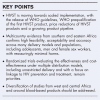Scaling up HIV self-testing in sub-Saharan Africa: a review of technology, policy and evidence
- PMID: 29232277
- PMCID: PMC5768229
- DOI: 10.1097/QCO.0000000000000426
Scaling up HIV self-testing in sub-Saharan Africa: a review of technology, policy and evidence
Abstract
Purpose of review: HIV self-testing (HIVST) can provide complementary coverage to existing HIV testing services and improve knowledge of status among HIV-infected individuals. This review summarizes the current technology, policy and evidence landscape in sub-Saharan Africa and priorities within a rapidly evolving field.
Recent findings: HIVST is moving towards scaled implementation, with the release of WHO guidelines, WHO prequalification of the first HIVST product, price reductions of HIVST products and a growing product pipeline. Multicountry evidence from southern and eastern Africa confirms high feasibility, acceptability and accuracy across many delivery models and populations, with minimal harms. Evidence on the effectiveness of HIVST on increased testing coverage is strong, while evidence on demand generation for follow-on HIV prevention and treatment services and cost-effective delivery is emerging. Despite these developments, HIVST delivery remains limited outside of pilot implementation.
Summary: Important technology gaps include increasing availability of more sensitive HIVST products in low and middle-income countries. Regulatory and postmarket surveillance systems for HIVST also require further development. Randomized trials evaluating the effectiveness and cost-effectiveness under multiple distribution models, including unrestricted delivery and with a focus on linkage to HIV prevention and treatment, remain priorities. Diversification of studies from west and central Africa and around blood-based products should be addressed.
Figures
References
-
- UNAIDS. AIDS by the numbers. Geneva, Switzerland: Joint United Nations Programme on HIV/AIDS (UNAIDS); 2016.
-
- UNAIDS. Ending AIDS: Progress towards the 90-90-90 targets. Geneva, Switzerland: Joint United Nations Programme on HIV/AIDS (UNAIDS); 2017.
-
- WHO. Guidelines on HIV self-testing and partner notification: supplement to consolidated guidelines on HIV testing services. Geneva, Switzerland: World Health Organization (WHO); 2016. - PubMed
-
- Unitaid and WHO. Market and technology landscape for HIV rapid diagostic tests for self-testing. Geneva, Switzerland: Unitaid and World Health Organization (WHO); 2017.
Publication types
MeSH terms
Grants and funding
LinkOut - more resources
Full Text Sources
Other Literature Sources
Medical
Research Materials



